Mapping Urban Segregation with GeoAI: Street View Perceptions and Socio-Spatial Inequality in Thessaloniki, Greece
Abstract
1. Introduction
- Can perceptual data extracted from SVIs help identify urban socio-spatial segregation?
- How does big-data geo-analysis enhance understanding of neighborhood qualities at metropolitan scale?
- To what extent do automated GeoAI methods and traditional geo-spatial analysis statistically and spatially align, and what do these comparisons reveal?
2. Theoretical and Methodological Background
2.1. The Quantification of Place Perception Studies
2.2. Perceptual Studies Using ML and AI
2.3. Study Area: Thessaloniki
3. Methodology and Data
3.1. Workflow Overview
- Step 1. Spatial framework definition: The Thessaloniki metropolitan area was delineated to include municipalities with continuous compact urban tissue and to exclude low-density peri-urban zones. The study adopts the Local Spatial Unit (LSU) used by the Greek census (ELSTAT), ensuring consistency with census neighborhood boundaries.
- Step 2. Preparation of socio-spatial data: Socio-economic and demographic variables were obtained from the 2011 ELSTAT Census (Panorama database) [74] together with objective property values from the Government Gazette [81]. After spatial harmonization to LSUs, Location Quotients (LQs) were computed to express the local concentration of each variable relative to the metropolitan average. Principal Component Analysis (PCA) [82] was then applied to the LQ set, reducing it to four latent socio-economic factors that summarize census data. PCA was considered necessary in order to reduce the dimensionality of the 21 socio-economic variables, initially selected as particularly relevant to our investigation.
- Step 3. Preparation of perceptual data: SVI from Mapillary and KartaView was processed with the open-source ZenSVI library. After preprocessing, SVIs were scored using the six pre-trained Place Pulse 2.0 perception models (one per each perception dimension). Perception scores were averaged within an H3 hexagonal grid and then aggregated to the LSU level.
- Step 4. Statistical and spatial analysis: Global Moran’s I [83] was first computed to verify the presence of spatial autocorrelation in both datasets. Pearson’s r [84] was then used to test linear associations between perception scores and socio-economic factors. Finally, bivariate Moran’s I [83] measured whether high (or low) values of one variable tended to occur near high (or low) values of another—indicating spatial co-location between objective and perceived dimensions of urban inequality.
3.2. Choice of Geographical Unit and Study Area Delineation
- Each LSU encompasses 700–1500 inhabitants, corresponding closely to the social and spatial scale at which neighborhood effects and socio-spatial inequalities are traced;
- LSUs are standardized across Greek cities, allowing consistent comparisons in future research beyond Thessaloniki;
- Census indicators are directly reported at LSU level, avoiding the need for ad hoc aggregation or disaggregation of data.
3.3. Socio-Spatial Data Processing
- (i)
- Economic variables, reflecting the professional composition of the population, economic sector of employment, unemployment rates, and non-active population, alongside “objective” property values for taxation from the Ministry of Finance [81].
- (ii)
- Social variables, characterizing selected aspects of residents’ conditions, including ethnic/national origin, housing conditions and amenities (car ownership, internet access, residential space per capita), and educational level (very high—very low, as the scope was to investigate extreme polarizations regarding educational status).
3.4. Perceptual Data Collection and Pre-Processing
3.5. Statistical Analysis of Socio-Economic and Perceptual Associations
4. Results
4.1. Socio-Spatial Analysis Results
- Factor F1—Industrial Economy & Deprivation–Affluence Axis: Contrasts areas dominated by industrial and technical occupations with zones of higher socio-economic advantage. Positive loadings: Secondary sector, industrial & technical jobs, small housing, and very low education. Negative loadings: Commerce/public sector), Land values, large housing, very high education. Land value (−0.831) highlights the deprivation-to-affluence continuum.
- Factor F2—Migrant Concentration and Resource Constraints: Defined by East European origin, Global South origin, no car, no internet. Negative loadings capture the Greek-origin majority with higher car ownership. This suggests migrant concentration with material deprivation, indicative of enclave-type segregation.
- Factor F3—Occupational Hierarchy: Positive loadings for directors and self-employed/technology. Negative loadings for technicians and manual/unspecialized. This factor separates managerial/technical elites from manual labor.
- Factor F4—Labor Market Detachment and Mobility Deficits: Captures unemployment and non-active population, with moderate positive loadings for no car and no internet variables. This may represent central-city groups such as retirees and students, who often lack mobility and digital resources, and are economically non-active.
4.2. Perceptual Analysis Results
4.3. Autocorrelation and Correlation of Socio-Spatial and Perceptual Data
5. Discussion
5.1. Socio-Spatial Differentiation Mirrored in the Image of the City
5.2. Urban Planning and Policy Implications
5.3. Limitations and Future Research
6. Conclusions
Author Contributions
Funding
Data Availability Statement
Acknowledgments
Conflicts of Interest
Appendix A

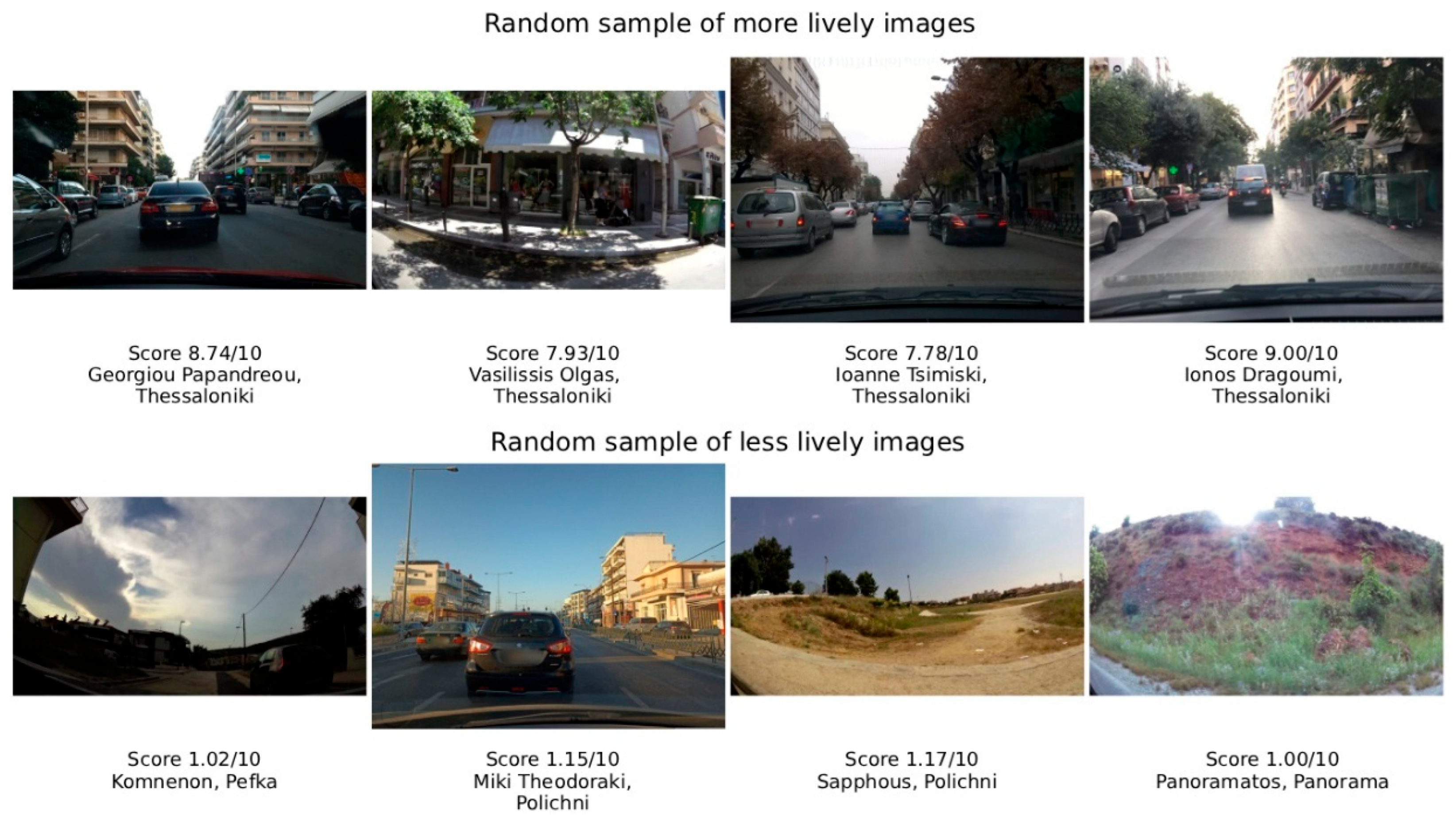


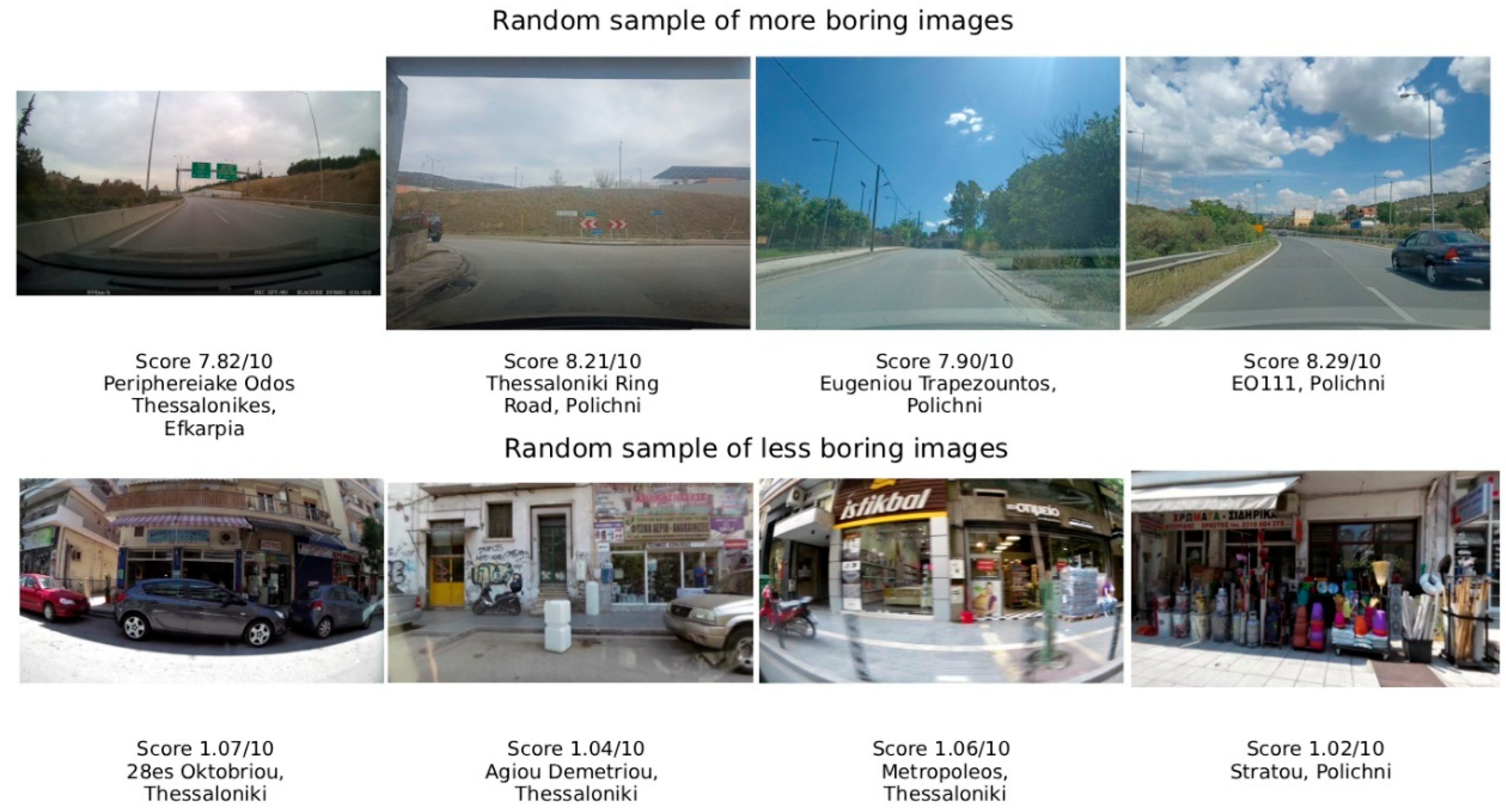
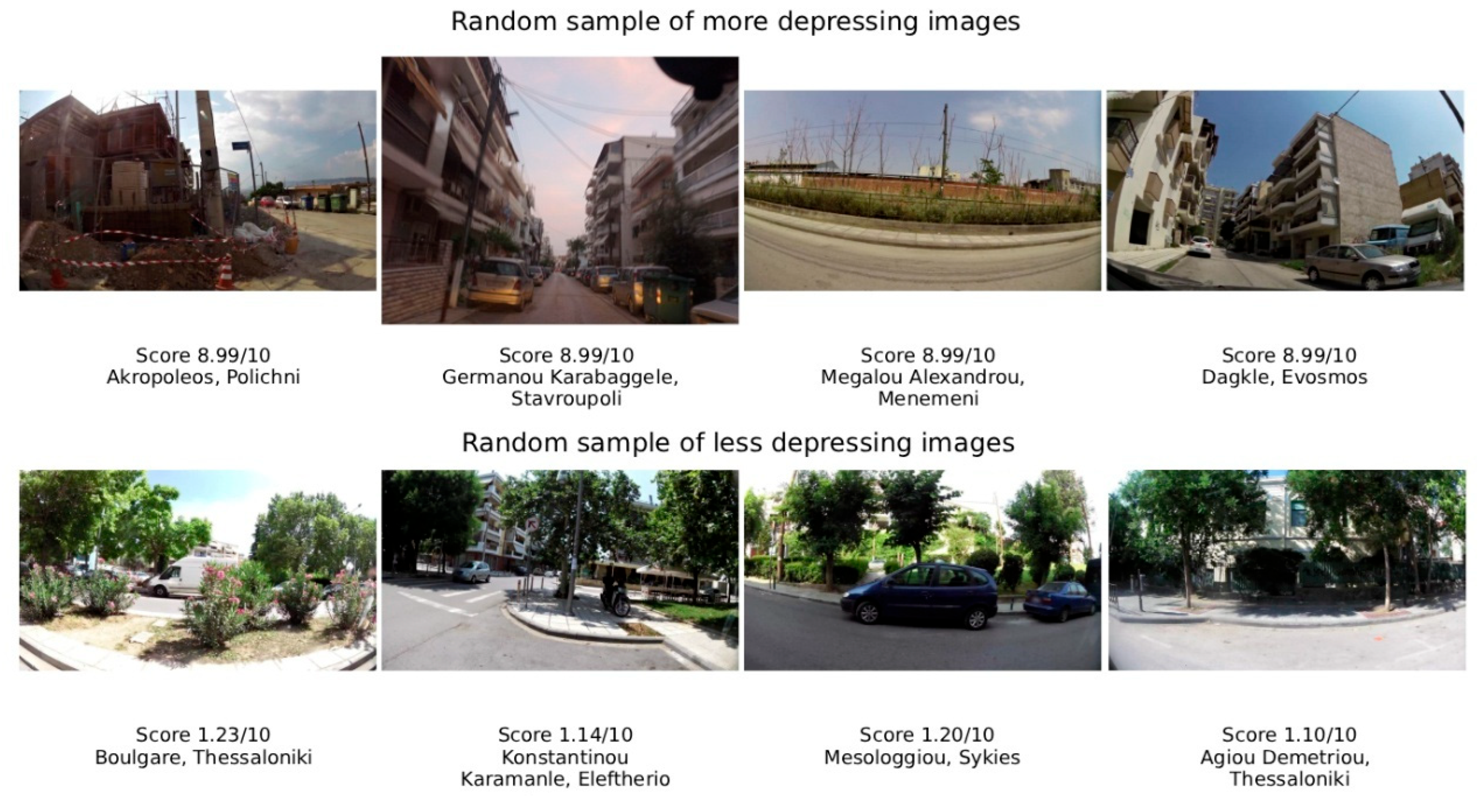
Appendix B
| Variable | Min | Max | Mean | Std. Dev. | Skewness | Kurtosis |
|---|---|---|---|---|---|---|
| Economic | ||||||
| EC_LQ1 Industrial | 0.24 | 2.25 | 0.99 | 0.33 | 0.48 | −0.40 |
| EC_LQ2 Commercial/Public | 0.60 | 1.23 | 1.00 | 0.10 | −0.38 | −0.29 |
| EC_LQ3 Directors | 0.18 | 3.62 | 0.99 | 0.48 | 2.12 | 6.96 |
| EC_LQ4 Self-employed/Tech | 0.11 | 2.20 | 1.00 | 0.41 | 0.28 | −0.77 |
| EC_LQ5 Office & Services | 0.42 | 1.54 | 1.00 | 0.15 | −0.68 | 1.70 |
| EC_LQ6 Technicians | 0.08 | 2.29 | 1.00 | 0.41 | 0.29 | −0.37 |
| EC_LQ7 Workers (Industry & Unskilled) | 0.14 | 2.38 | 1.00 | 0.44 | 0.32 | −0.55 |
| EC_LQ8 Unemployed | 0.17 | 4.14 | 1.04 | 0.48 | 1.45 | 4.19 |
| EC_LQ9 Non-active | 0.71 | 1.33 | 1.00 | 0.08 | 0.02 | 1.97 |
| EC_LQ10 Land Values | 0.47 | 1.96 | 1.00 | 0.26 | 0.87 | 1.48 |
| Social | ||||||
| SOC_LQ1 Greek origin | 0.72 | 1.06 | 1.00 | 0.05 | −1.33 | 2.45 |
| SOC_LQ2 Origin: Developed countries | 0.00 | 22.83 | 1.05 | 1.88 | 5.92 | 45.50 |
| SOC_LQ3 Origin: East European | 0.00 | 4.24 | 1.03 | 0.80 | 1.04 | 0.70 |
| SOC_LQ4 Origin: Global South | 0.00 | 12.69 | 1.03 | 1.17 | 3.84 | 28.78 |
| SOC_LQ6 Households w/o car | 0.09 | 2.73 | 1.02 | 0.49 | 0.60 | 0.12 |
| SOC_LQ7 No Internet | 0.21 | 2.16 | 1.01 | 0.26 | 0.04 | 1.12 |
| SOC_LQ8 Housing space < 20 m2/person | 0.05 | 2.56 | 0.99 | 0.44 | 0.25 | −0.28 |
| SOC_LQ9 Housing space > 50 m2/person | 0.43 | 1.65 | 1.00 | 0.22 | −0.04 | −0.40 |
| SOC_LQ10 Very high education | 0.00 | 8.01 | 1.01 | 1.02 | 2.05 | 6.06 |
| SOC_LQ11 Very low education | 0.31 | 2.66 | 1.00 | 0.28 | 0.62 | 2.41 |
| Variable | Extraction | Variable | Extraction |
|---|---|---|---|
| EC_LQ1 | 0.868 | SOC_LQ1 | 0.954 |
| EC_LQ2 | 0.901 | SOC_LQ3 | 0.816 |
| EC_LQ3 | 0.814 | SOC_LQ4 | 0.776 |
| EC_LQ4 | 0.903 | SOC_LQ5 | 0.819 |
| EC_LQ6 | 0.850 | SOC_LQ6 | 0.904 |
| EC_LQ7 | 0.835 | SOC_LQ7 | 0.798 |
| EC_LQ8 | 0.676 | SOC_LQ8 | 0.874 |
| EC_LQ9 | 0.694 | SOC_LQ9 | 0.712 |
| EC_LQ10 | 0.756 | SOC_LQ10 | 0.738 |
| SOC_LQ11 | 0.767 |
| Component | Eigenvalue | % Variance | Cumulative % |
|---|---|---|---|
| 1 | 9.44 | 49.70 | 49.70 |
| 2 | 3.73 | 19.68 | 69.33 |
| 3 | 1.20 | 6.29 | 75.63 |
| 4 | 1.08 | 5.65 | 81.30 |
| 5+ | <1.00 | — | — |
| Component | ||||
|---|---|---|---|---|
| 1 | 2 | 3 | 4 | |
| EC_LQ1 | 0.890 | 0.213 | −0.157 | |
| EC_LQ2 | −0.893 | −0.214 | 0.130 | −0.199 |
| EC_LQ3 | −0.278 | −0.149 | 0.822 | −0.195 |
| EC_LQ4 | −0.715 | 0.615 | ||
| EC_LQ6 | 0.662 | 0.113 | −0.624 | |
| EC_LQ7 | 0.627 | 0.160 | −0.644 | |
| EC_LQ8 | 0.243 | 0.781 | ||
| EC_LQ9 | −0.222 | 0.285 | 0.751 | |
| EC_LQ10 | −0.830 | 0.257 | ||
| SOC_LQ1 | −0.201 | −0.937 | −0.184 | |
| SOC_LQ3 | 0.381 | 0.800 | 0.173 | |
| SOC_LQ4 | 0.871 | −0.103 | ||
| SOC_LQ5 | −0.157 | −0.555 | 0.384 | −0.581 |
| SOC_LQ6 | −0.117 | 0.711 | −0.192 | 0.589 |
| SOC_LQ7 | 0.469 | 0.531 | −0.238 | 0.489 |
| SOC_LQ8 | 0.897 | 0.178 | −0.194 | |
| SOC_LQ9 | −0.821 | −0.161 | 0.102 | |
| SOC_LQ10 | −0.745 | −0.105 | 0.357 | −0.212 |
| SOC_LQ11 | 0.841 | −0.123 | 0.199 | |
| Perception | Factor | I | CI (95%) | p | q (BH-FDR) | Significant (95%) |
|---|---|---|---|---|---|---|
| safer | F1 | −0.43 | −0.08 to 0.08 | 0.001 | 0.002 | ✓ |
| F2 | 0.05 | −0.06 to 0.07 | 0.095 | 0.095 | ||
| F3 | 0.06 | −0.07 to 0.07 | 0.040 | 0.053 | ||
| F4 | 0.13 | −0.06 to 0.07 | 0.001 | 0.002 | ✓ | |
| livelier | F1 | −0.37 | −0.08 to 0.07 | 0.001 | 0.001 | ✓ |
| F2 | 0.19 | −0.06 to 0.07 | 0.001 | 0.001 | ✓ | |
| F3 | −0.06 | −0.05 to 0.05 | 0.011 | 0.011 | ✓ | |
| F4 | 0.24 | −0.06 to 0.06 | 0.001 | 0.001 | ✓ | |
| wealthier | F1 | −0.45 | −0.08 to 0.08 | 0.001 | 0.001 | ✓ |
| F2 | 0.17 | −0.07 to 0.06 | 0.001 | 0.001 | ✓ | |
| F3 | 0.01 | −0.07 to 0.06 | 0.423 | 0.423 | ||
| F4 | 0.21 | −0.06 to 0.06 | 0.001 | 0.001 | ✓ | |
| more beautiful | F1 | −0.36 | −0.06 to 0.06 | 0.001 | 0.002 | ✓ |
| F2 | 0.02 | −0.07 to 0.07 | 0.279 | 0.279 | ||
| F3 | 0.09 | −0.05 to 0.05 | 0.001 | 0.002 | ✓ | |
| F4 | 0.08 | −0.05 to 0.05 | 0.003 | 0.004 | ✓ | |
| more boring | F1 | 0.03 | −0.05 to 0.06 | 0.155 | 0.155 | |
| F2 | −0.24 | −0.06 to 0.06 | 0.001 | 0.001 | ✓ | |
| F3 | 0.11 | −0.05 to 0.05 | 0.001 | 0.001 | ✓ | |
| F4 | −0.16 | −0.06 to 0.05 | 0.001 | 0.001 | ✓ | |
| more depressing | F1 | 0.36 | −0.07 to 0.07 | 0.001 | 0.002 | ✓ |
| F2 | −0.06 | −0.06 to 0.06 | 0.023 | 0.023 | ✓ | |
| F3 | −0.07 | −0.05 to 0.05 | 0.001 | 0.002 | ✓ | |
| F4 | −0.08 | −0.06 to 0.06 | 0.005 | 0.007 | ✓ |
References
- Dujardin, C.; Selod, H.; Thomas, I. Residential Segregation and Unemployment: The Case of Brussels. Urban Stud. 2008, 45, 89–113. [Google Scholar] [CrossRef]
- Massey, D.S.; Denton, N.A. The Dimensions of Residential Segregation. Soc. Forces 1988, 67, 281–315. [Google Scholar] [CrossRef]
- Harvey, D. From Managerialism to Entrepreneurialism: The Transformation in Urban Governance in Late Capitalism. Geogr. Annaler. Ser. B Hum. Geogr. 1989, 71, 3–17. [Google Scholar] [CrossRef]
- Hillier, B.; Hanson, J. The Social Logic of Space; Cambridge University Press: Cambridge, UK, 1984. [Google Scholar]
- Chen, F.; Nielsen, C.P.; Wu, J.; Chen, X. Examining Socio-Spatial Differentiation under Housing Reform and Its Implications for Mobility in Urban China. Habitat Int. 2022, 119, 102498. [Google Scholar] [CrossRef]
- Harvey, D. The Right to the City. New Left Rev. 2008, 53, 23–40. [Google Scholar] [CrossRef]
- Soja, E.W. Seeking Spatial Justice; University of Minnesota Press: Minneapolis, MN, USA, 2010. [Google Scholar]
- Oxford Reference Entry. Available online: https://www.oxfordreference.com/display/10.1093/oi/authority.20110803100521633 (accessed on 14 September 2025).
- Smith, N. The New Urban Frontier: Gentrification and the Revanchist City, 1st ed.; Routledge: Abingdon, UK, 1996. [Google Scholar]
- Luisa Maffini, A.; Maraschin, C. Urban Segregation and Socio-Spatial Interactions: A Configurational Approach. Urban Sci. 2018, 2, 55. [Google Scholar] [CrossRef]
- Knox, P.; Pinch, S. Urban Social Geography: An Introduction; Routledge: Abingdon, UK, 2014. [Google Scholar]
- Musterd, S. Handbook of Urban Segregation; Edward Elgar Publishing: Cheltenham, UK, 2020; ISBN 978-1-78811-560-5. [Google Scholar]
- Sassen, S. The Global City: New York, London, Tokyo; Princeton University Press: Princeton, NJ, USA, 2001. [Google Scholar]
- Swyngedouw, E.; Heynen, N.C. Urban Political Ecology, Justice and the Politics of Scale. Antipode 2003, 35, 898–918. [Google Scholar] [CrossRef]
- Legeby, A. Urban Segregation and Urban Form: From Residential Segregation to Segregation in Public Space; KTH: Stockholm, Sweden, 2010. [Google Scholar]
- Gaffikin, F.; Morrissey, M. Planning in Divided Cities; Wiley-Blackwell: Oxford, UK, 2011. [Google Scholar]
- Marcuse, P. Gentrification, Abandonment, and Displacement. J. Urban Contemp. Law 1985, 28, 195–240. [Google Scholar]
- Lehman-Frisch, S. La ségrégation: Une injustice spatiale? Questions de recherche. Ann. De Géographie 2009, 665–666, 94–115. [Google Scholar] [CrossRef]
- Duncan, O.D.; Duncan, B. A Methodological Analysis of Segregation Indexes. Am. Sociol. Rev. 1955, 20, 210–217. [Google Scholar] [CrossRef]
- Reardon, S.F.; O’Sullivan, D. Measures of Spatial Segregation. Sociol. Methodol. 2004, 34, 121–162. [Google Scholar] [CrossRef]
- Maloutas, T. Socio-Economic Segregation in Athens at the Beginning of the Twenty-First Century. In Socio-Economic Segregation in European Capital Cities: East Meets West; Routledge: London, UK; New York, NY, USA, 2016; pp. 156–185. [Google Scholar]
- Faka, A.; Kalogeropoulos, K.; Maloutas, T.; Chalkias, C. Spatial Variability and Clustering of Quality of Life at Local Level: A Geographical Analysis in Athens, Greece. ISPRS Int. J. Geo-Inf. 2022, 11, 276. [Google Scholar] [CrossRef]
- Noble, M.; Wright, G.; Smith, G.; Dibben, C. Measuring Multiple Deprivation at the Small-Area Level. Environ. Plan. A 2006, 38, 169–185. [Google Scholar] [CrossRef]
- Livingston, M.; Lee, D. “The Glasgow Effect?” The Result of the Geographical Patterning of Deprived Areas? Health Place 2014, 29, 1–9. [Google Scholar] [CrossRef]
- Butina, G.W.; Bentley, I. Identity by Design; Elsevier: Oxford, UK, 2007. [Google Scholar]
- Bentley, I.; Alcock, A.; Murrain, P.; McGlynn, S.; Smith, G. Responsive Environments: A Manual for Designers; Architectural Press: London, UK, 1985. [Google Scholar]
- Batty, M. Defining Geodesign (= GIS + Design?). Environ. Plan. B Plan. Des. 2013, 40, 1–2. [Google Scholar] [CrossRef]
- Batty, M. Cities and Complexity: Understanding Cities with Cellular Automata, Agent-Based Models, and Fractals; MIT Press: Cambridge, MA, USA, 2007. [Google Scholar]
- Montello, D.R. Cognitive Research in GIScience: Recent Achievements and Future Prospects. Geogr. Compass 2009, 3, 1824–1840. [Google Scholar] [CrossRef]
- Nasar, J.L. The Evaluative Image of the City; Sage: Thousand Oaks, CA, USA, 1998. [Google Scholar]
- Quercia, D.; Schifanella, R.; Aiello, L.M. The Shortest Path to Happiness: Recommending Beautiful, Quiet, and Happy Routes in the City. In Proceedings of the 25th ACM Conference on Hypertext and Social Media, Santiago, Chile, 1–4 September 2014; ACM: New York, NY, USA, 2014; pp. 116–125. [Google Scholar]
- Rossetti, T.; Lobel, H.; Rocco, V.; Hurtubia, R. Explaining Subjective Perceptions of Public Spaces as a Function of the Built Environment: A Massive Data Approach. Landsc. Urban Plan. 2019, 181, 169–178. [Google Scholar] [CrossRef]
- De Nadai, M.; Vieriu, R.L.; Zen, G.; Dragicevic, S.; Naik, N.; Caraviello, M.; Hidalgo, C.A.; Sebe, N.; Lepri, B. Are Safer Looking Neighborhoods More Lively? A Multimodal Investigation into Urban Life. In Proceedings of the 24th ACM International Conference on Multimedia, Amsterdam, The Netherlands, 1 October 2016; Association for Computing Machinery: New York, NY, USA; pp. 1127–1135. [Google Scholar]
- Salesses, P.; Schechtner, K.; Hidalgo, C.A. The Collaborative Image of the City: Mapping the Inequality of Urban Perception. PLoS ONE 2013, 8, e68400. [Google Scholar] [CrossRef]
- Jiang, Y.; Zhu, Y.; Tang, F.; Chung, T.; Wu, B. Residential Segregation, Perceived Neighborhood Environment, and All-Cause Mortality Among Community-Dwelling Older Chinese Americans. J. Gerontol. B Psychol. Sci. Soc. Sci. 2023, 78, 2071–2079. [Google Scholar] [CrossRef] [PubMed]
- Dixon, J.; Sturgeon, B.; Huck, J.; Hocking, B.; Jarman, N.; Bryan, D.; Whyatt, D.; Davies, G.; Tredoux, C. Navigating the Divided City: Place Identity and the Time-Geography of Segregation. J. Environ. Psychol. 2022, 84, 101908. [Google Scholar] [CrossRef]
- Roberto, E.; Korver-Glenn, E. The Spatial Structure and Local Experience of Residential Segregation. Spat. Demogr. 2021, 9, 277–307. [Google Scholar] [CrossRef]
- Pfirsch, T.; Semi, G. Segregation in the Cities of the European Mediterranean. Méditerranée Rev. Géograph. Pays Méditerranéens 2016, 15–23. [Google Scholar]
- Grzegorczyk, A. Residential Segregation and Socio-Spatial Processes in Marseille. Urban Social Sustainability Challenge. Bull. Geogr. Socio-Econ. Ser. 2021, 52, 25–38. [Google Scholar] [CrossRef]
- Garcia-Lopez, M.À.; Nicolini, R.; Roig, J.L. Segregation and Urban Spatial Structure in Barcelona. Pap. Reg. Sci. 2020, 99, 749–772. [Google Scholar] [CrossRef]
- Lynch, K. The Image of the City; MIT Press: Cambridge, MA, USA, 1960. [Google Scholar]
- Norberg-Schulz, C. Genius Loci: Towards a Phenomenology of Architecture; Rizzoli: New York, NY, USA, 1980; ISBN 978-0-8478-0287-6. [Google Scholar]
- Kostof, S. The City Shaped: Urban Patterns and Meanings Through History; Bulfinch Press: Boston, MA, USA, 1991; ISBN 978-0-8212-1867-9. [Google Scholar]
- Cullen, G. The Concise Townscape; Routledge: New York, NY, USA, 1961. [Google Scholar]
- Appleyard, D.; Myer, J.R.; Lynch, K. The View from the Road; Harvard-MIT Joint Center for Urban Studies Series; MIT Press: Cambridge, MA, USA, 1965; ISBN 978-0-262-01015-3. [Google Scholar]
- Whyte, W.H. The Social Life of Small Urban Spaces; Conservation Foundation: Washington, DC, USA, 1980. [Google Scholar]
- Jacobs, A.B. Great Streets; MIT Press: Cambridge, MA, USA, 1993; ISBN 978-0-262-10048-9. [Google Scholar]
- Tversky, B. Structures Of Mental Spaces: How People Think About Space. Environ. Behav. 2003, 35, 66–80. [Google Scholar] [CrossRef]
- Batty, M. Big Data, Smart Cities and City Planning. Dialogues Hum. Geogr. 2013, 3, 274–279. [Google Scholar] [CrossRef] [PubMed]
- Cranshaw, J.; Schwartz, R.; Hong, J.; Sadeh, N. The Livehoods Project: Utilizing Social Media to Understand the Dynamics of a City. In Proceedings of the international AAAI conference on web and social media, Copenhagen, Denmark, 23–26 June 2012; Volume 6, pp. 58–65. [Google Scholar] [CrossRef]
- Hollenstein, L.; Purves, R. Exploring Place through User-Generated Content: Using Flickr Tags to Describe City Cores. J. Spat. Inf. Sci. 2010, 1, 21–48. [Google Scholar]
- Dunkel, A. Visualizing the Perceived Environment Using Crowdsourced Photo Geodata. Landsc. Urban Plan. 2015, 142, 173–186. [Google Scholar] [CrossRef]
- Biljecki, F.; Ito, K. Street View Imagery in Urban Analytics and GIS: A Review. Landsc. Urban Plan. 2021, 215, 104217. [Google Scholar] [CrossRef]
- Zhang, F.; Salazar-Miranda, A.; Duarte, F.; Vale, L.; Hack, G.; Chen, M.; Liu, Y.; Batty, M.; Ratti, C. Urban Visual Intelligence: Studying Cities with Artificial Intelligence and Street-Level Imagery. Ann. Am. Assoc. Geogr. 2024, 114, 876–897. [Google Scholar] [CrossRef]
- Wei, J.; Yue, W.; Li, M.; Gao, J. Mapping Human Perception of Urban Landscape from Street-View Images: A Deep-Learning Approach. Int. J. Appl. Earth Obs. Geoinf. 2022, 112, 102886. [Google Scholar] [CrossRef]
- Abascal, A.; Vanhuysse, S.; Grippa, T.; Rodriguez-Carreño, I.; Georganos, S.; Wang, J.; Kuffer, M.; Martinez-Diez, P.; Santamaria-Varas, M.; Wolff, E. AI Perceives like a Local: Predicting Citizen Deprivation Perception Using Satellite Imagery. npj Urban Sustain. 2024, 4, 20. [Google Scholar] [CrossRef]
- Danish, M.; Labib, S.M.; Ricker, B.; Helbich, M. A Citizen Science Toolkit to Collect Human Perceptions of Urban Environments Using Open Street View Images. Comput. Environ. Urban Syst. 2025, 116, 102207. [Google Scholar] [CrossRef]
- Zhang, J.; Li, Y.; Fukuda, T.; Wang, B. Urban Safety Perception Assessments via Integrating Multimodal Large Language Models with Street View Images. Cities 2025, 165, 106122. [Google Scholar] [CrossRef]
- Zhou, Q.; Zhang, J.; Zhu, Z. Evaluating Urban Visual Attractiveness Perception Using Multimodal Large Language Model and Street View Images. Buildings 2025, 15, 2970. [Google Scholar] [CrossRef]
- Kang, H.-W.; Kang, H.-B. Prediction of Crime Occurrence from Multi-Modal Data Using Deep Learning. PLoS ONE 2017, 12, e0176244. [Google Scholar] [CrossRef]
- Hou, Y.; Quintana, M.; Khomiakov, M.; Yap, W.; Ouyang, J.; Ito, K.; Wang, Z.; Zhao, T.; Biljecki, F. Global Streetscapes—A Comprehensive Dataset of 10 Million Street-Level Images across 688 Cities for Urban Science and Analytics. ISPRS J. Photogramm. Remote Sens. 2024, 215, 216–238. [Google Scholar] [CrossRef]
- Dubey, A.; Naik, N.; Parikh, D.; Raskar, R.; Hidalgo, C.A. Deep Learning the City: Quantifying Urban Perception at a Global Scale. In Proceedings of the Computer Vision—ECCV 2016; Leibe, B., Matas, J., Sebe, N., Welling, M., Eds.; Springer International Publishing: Cham, Switzerland, 2016; pp. 196–212. [Google Scholar]
- Ito, K.; Zhu, Y.; Abdelrahman, M.; Liang, X.; Fan, Z.; Hou, Y.; Zhao, T.; Ma, R.; Fujiwara, K.; Ouyang, J.; et al. ZenSVI: An Open-Source Software for the Integrated Acquisition, Processing and Analysis of Street View Imagery towards Scalable Urban Science. Comput. Environ. Urban Syst. 2025, 119, 102283. [Google Scholar] [CrossRef]
- Li, X.; Zhang, C.; Li, W. Does the Visibility of Greenery Increase Perceived Safety in Urban Areas? Evidence from the Place Pulse 1.0 Dataset. ISPRS Int. J. Geo-Inf. 2015, 4, 1166–1183. [Google Scholar] [CrossRef]
- Zhang, Y.; Wang, X.; Ye, Y.; Wang, L.; Zhang, Y.; Qin, W.; Chi, Y.; Liu, G.; Yao, S. Nonlinear Relationships and Interaction Effects of Urban Built Environment on Urban Vitality Based on Explainable Machine Learning. City Environ. Interact. 2025, 28, 100244. [Google Scholar] [CrossRef]
- Le, Q.H.; Dinh, N.N.H.; Kim, B.; Ahn, Y. Scalable Transfer Learning Framework for Capturing Human Perceptions of Place through Visual-Aural Data Integration. Cities 2025, 166, 106286. [Google Scholar] [CrossRef]
- Gemenetzi, G. Thessaloniki: The Changing Geography of the City and the Role of Spatial Planning. Cities 2017, 64, 88–97. [Google Scholar] [CrossRef]
- Maloutas, T. Segregation, Social Polarization and Immigration in Athens during the 1990s: Theoretical Expectations and Contextual Difference. Int. J. Urban Reg. Res. 2007, 31, 733–758. [Google Scholar] [CrossRef]
- Arapoglou, V.; Maloutas, T. Segregation, Inequality and Marginality in Context: The Case of Athens. Greek Rev. Soc. Res. 2011, 136, 135–155. [Google Scholar] [CrossRef]
- Arapoglou, V.P.; Spyrellis, S.N. Arrival Infrastructures: Segregation of Displaced Migrants and Processes of Urban Change in Athens. Geographies 2024, 4, 182–202. [Google Scholar] [CrossRef]
- Leontidou, L. The Mediterranean City in Transition: Social Change and Urban Development; Cambridge University Press: Cambridge, MA, USA, 1990. [Google Scholar]
- Leontidou, L. Alternatives to Modernism in (Southern) Urban Theory: Exploring In-Between Spaces. Int. J. Urban Reg. Res. 1996, 20, 178–195. [Google Scholar] [CrossRef]
- Maloutas, T. The Social Geography of Athens: Social Groups and Structured Environment in a Southern European Metropolis; Alexandreia: Athens, Greece, 2018. [Google Scholar]
- Hellenic Statistical Authority (ELSTAT). 2011 Population and Housing Census: Final Results. Available online: https://www.statistics.gr/en/2011-census-pop-hous (accessed on 14 September 2025).
- Kalogirou, N. The Palimpsest of Aristotelous: Byzantine Visions and Eclectic Localism; University Studio Press: Thessaloniki, Greece, 2021. [Google Scholar]
- Lagopoulos, A. Monumental Urban Space and National Identity: The Early Twentieth Century New Plan of Thessaloniki. J. Hist. Geogr. 2005, 31, 61–77. [Google Scholar] [CrossRef]
- Yerolympos, A. Thessaloniki (Salonika) before and after 1917. Twentieth Century Planning versus 20 Centuries of Urban Evolution. Plan. Perspect. 1988, 3, 141–166. [Google Scholar] [CrossRef]
- Oikonomou, M.; Christodoulou, C. Evolution and Transformation Processes of Urban Form: Urban Tissues in Thessaloniki, Greece. In Proceedings of the XXIX International Seminar on Urban Form ISUF 2022 Urban Redevelopment and Revitalisation. A Multidisciplinary Perspective, Łódź, Poland; Kraków, Poland, 6 June–11 September 2022; Lodz University of Technology Press: Łódź, Poland. [Google Scholar]
- Lagarias, A. Exploring Land Use Policy Scenarios with the Use of a Cellular Automata-Based Model: Urban Sprawl Containment and Sustainable Development in Thessaloniki. Geocarto Int. 2015, 30, 1033–1051. [Google Scholar] [CrossRef]
- Lafazani, P.; Lagarias, A. Applying Multiple and Logistic Regression Models to Investigate Periurban Processes in Thessaloniki, Greece. Geocarto Int. 2016, 31, 927–942. [Google Scholar] [CrossRef]
- National Printing House. Adjustment of the Starting Prices of the Areas Included in the System of Objective Determination of the Taxable Value of Real Estate and Entry into Force of the Provisions of Article 41 of Law 1249/1982, and Determination of Starting Prices and Their Adjustment Coefficients for the Determination of the Taxable Value of Real Estate Located in Other Areas within the Plan or Boundaries of Settlements According to the Objective System. Government Gazette of the Hellenic Republic, Series B, No. 2375/21-05-2021. Available online: https://www.et.gr/api/DownloadFeksApi/?fek_pdf=20210202375 (accessed on 13 September 2025).
- Jolliffe, I.T.; Cadima, J. Principal Component Analysis: A Review and Recent Developments. Philos. Trans. R. Soc. A Math. Phys. Eng. Sci. 2016, 374, 20150202. [Google Scholar] [CrossRef]
- Anselin, L. Local Indicators of Spatial Association—LISA. Geogr. Anal. 1995, 27, 93–115. [Google Scholar] [CrossRef]
- Pearson, K. VII. Mathematical Contributions to the Theory of Evolution.—III. Regression, Heredity, and Panmixia. Philos. Trans. R. Soc. London. Ser. A Contain. Pap. A Math. or Phys. Character 1896, 187, 253–318. [Google Scholar] [CrossRef]
- ΕΚΚΕ-ΕLSTAT Panorama of Greek Census Data 1991–2011. Available online: https://panoramaps2.statistics.gr/ (accessed on 14 September 2025).
- Crawley, A.; Beynon, M.; Munday, M. Making Location Quotients More Relevant as a Policy Aid in Regional Spatial Analysis. Urban Stud. 2013, 50, 1854–1869. [Google Scholar] [CrossRef]
- Kaiser, H.F. An Index of Factorial Simplicity. Psychometrika 1974, 39, 31–36. [Google Scholar] [CrossRef]
- Bartlett, M.S. Tests of Significance in Factor Analysis. Br. J. Psychol. 1950, 3, 77–85. [Google Scholar] [CrossRef]
- Mapillary. Available online: https://www.mapillary.com/app/ (accessed on 29 April 2025).
- KartaView. Available online: https://kartaview.org/ (accessed on 29 April 2025).
- Benjamini, Y.; Hochberg, Y. Controlling the False Discovery Rate: A Practical and Powerful Approach to Multiple Testing. J. R. Stat. Soc. Ser. B (Methodol.) 1995, 57, 289–300. [Google Scholar] [CrossRef]
- Arbaci, S. Ethnic Segregation, Housing Systems and Welfare Regimes in Europe. Eur. J. Hous. Policy 2007, 7, 401–433. [Google Scholar] [CrossRef]
- Malheiros, J. Ethni-Cities: Residential Patterns in the Northern European and Mediterranean Metropolises. Implications for Pol-icy Design. Int. J. Popul. Geogr. 2002, 8, 107–134. [Google Scholar] [CrossRef]
- Gospodini, A. Urban Morphology and Place Identity in European Cities: Built Heritage and Innovative Design. J. Urban Des. 2004, 9, 225–248. [Google Scholar] [CrossRef]

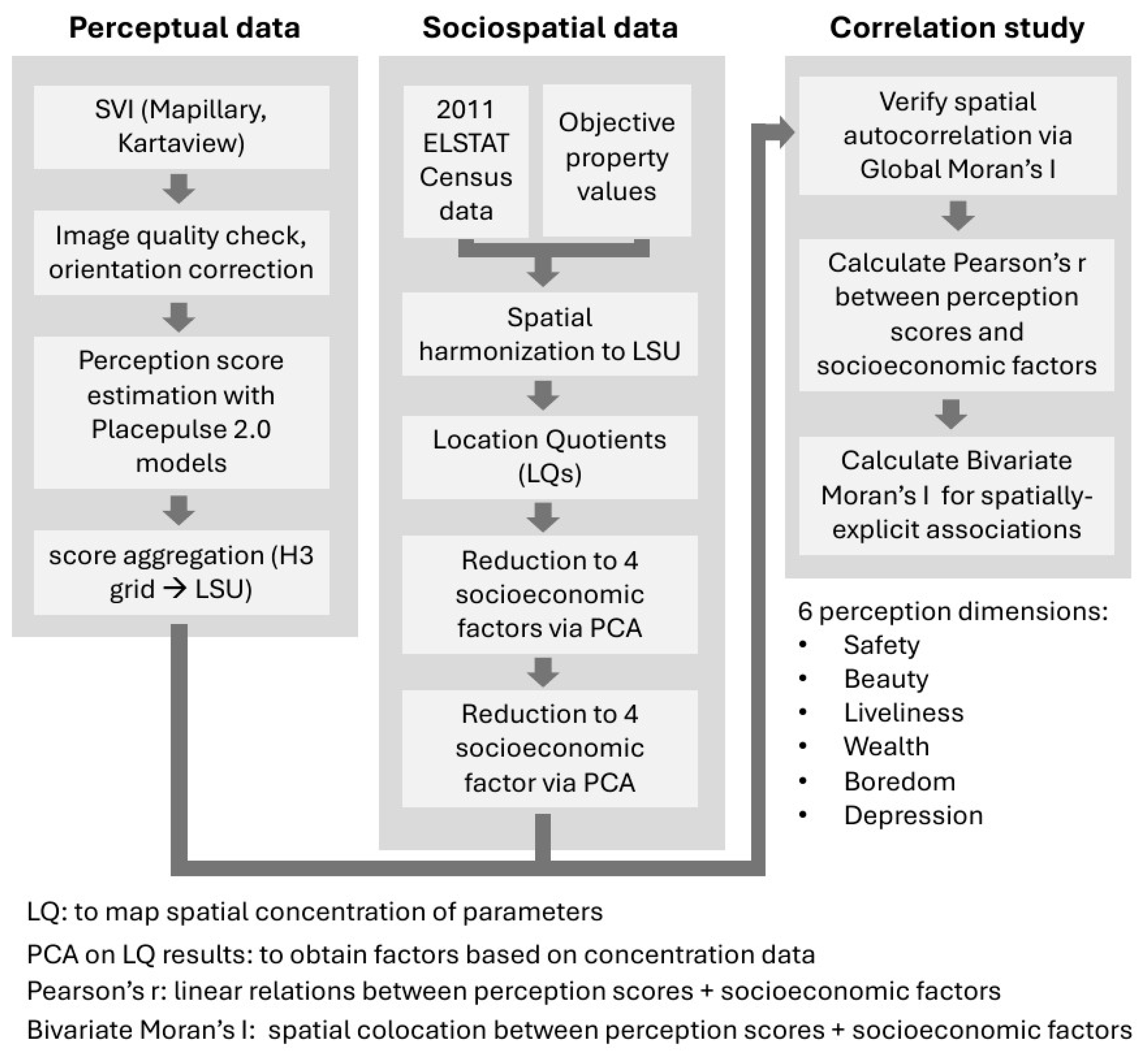
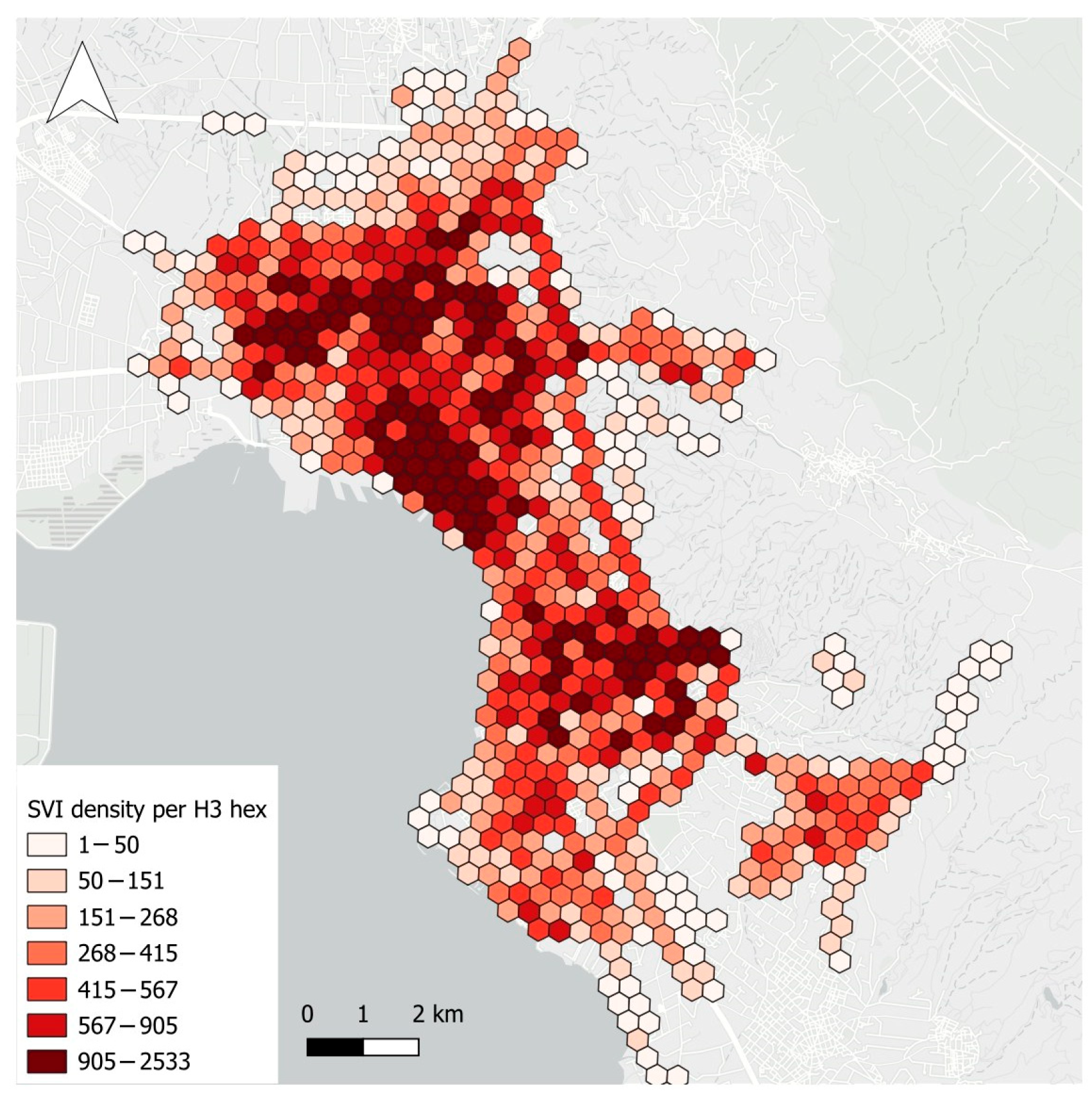
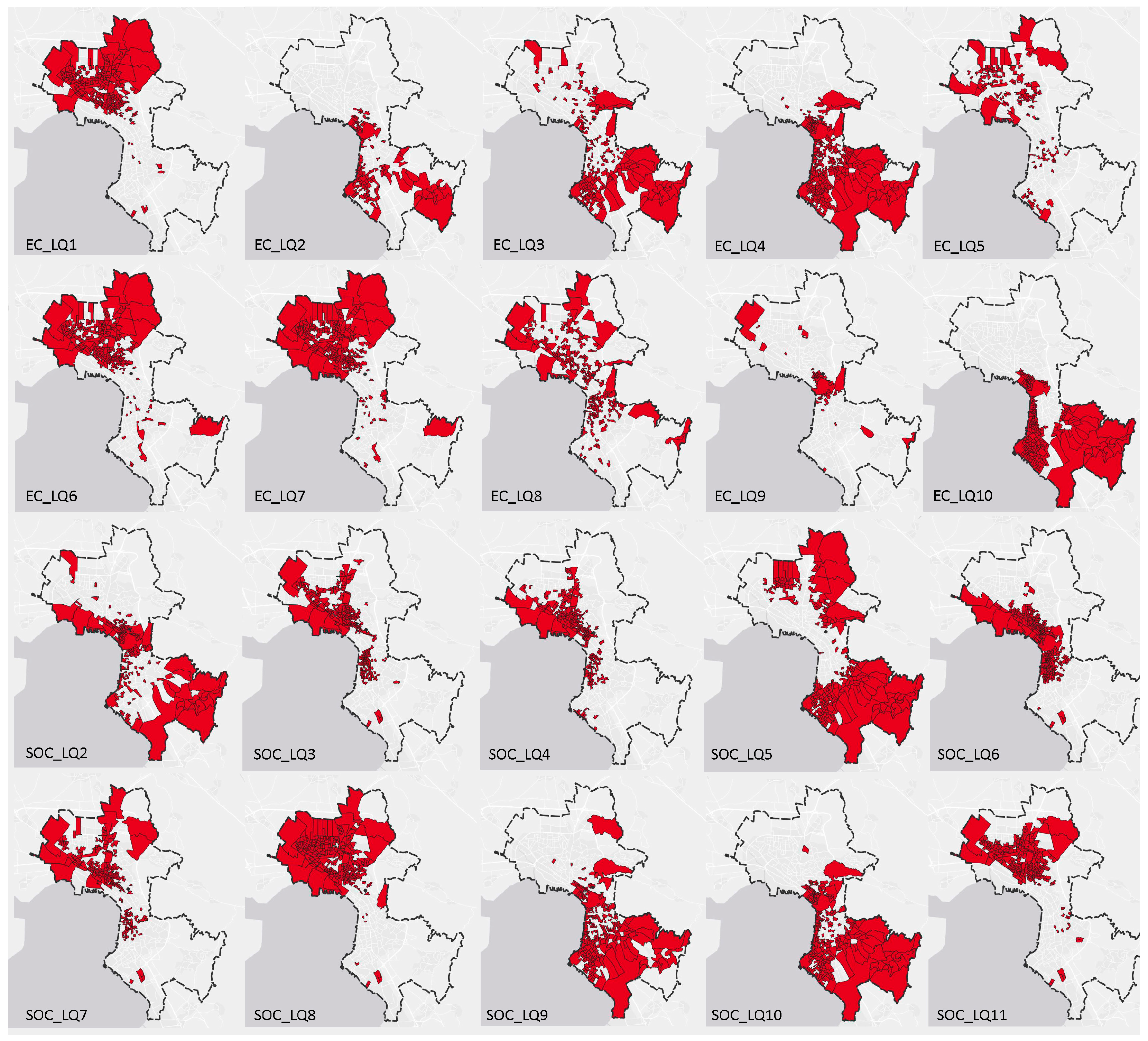
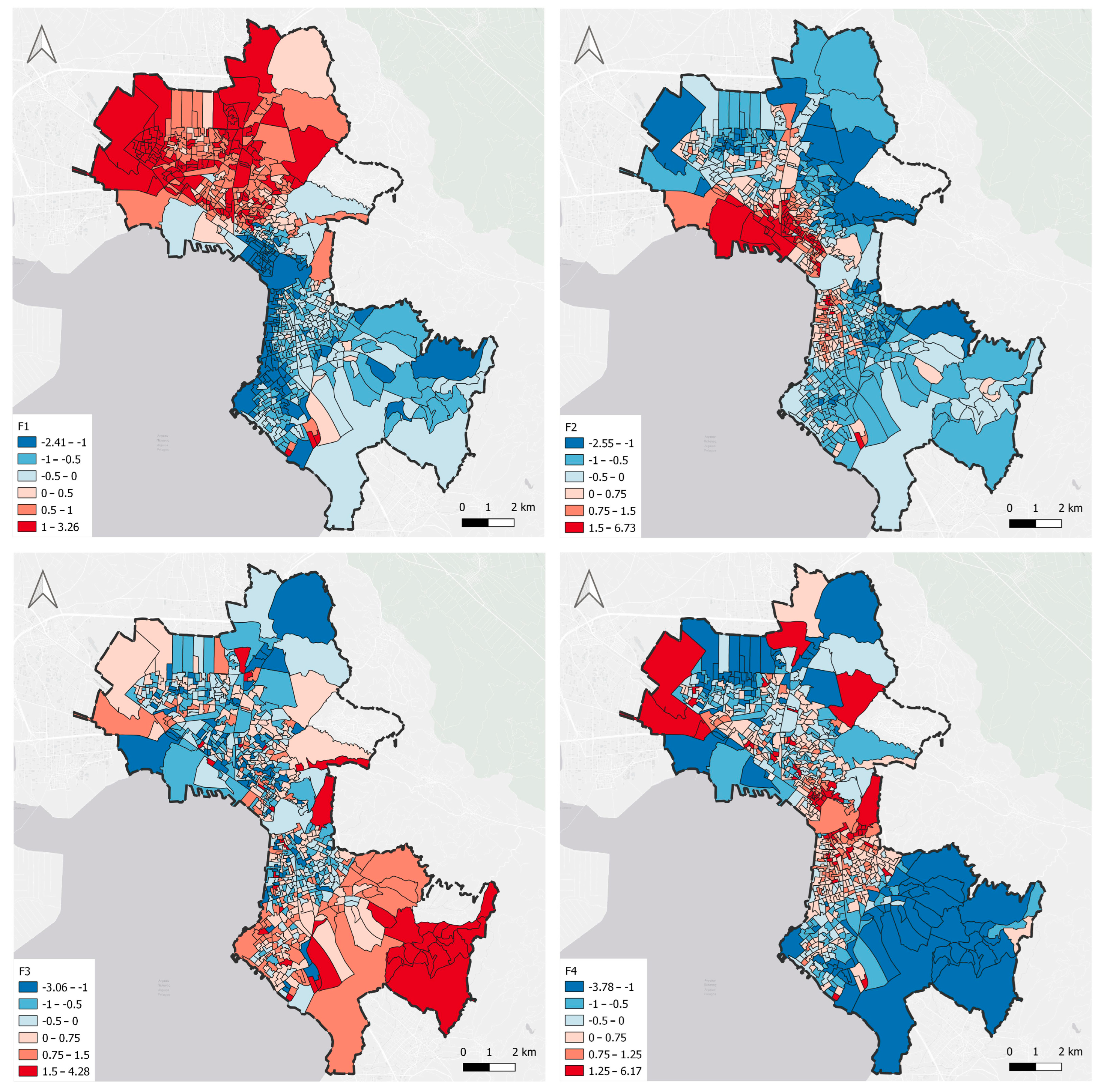
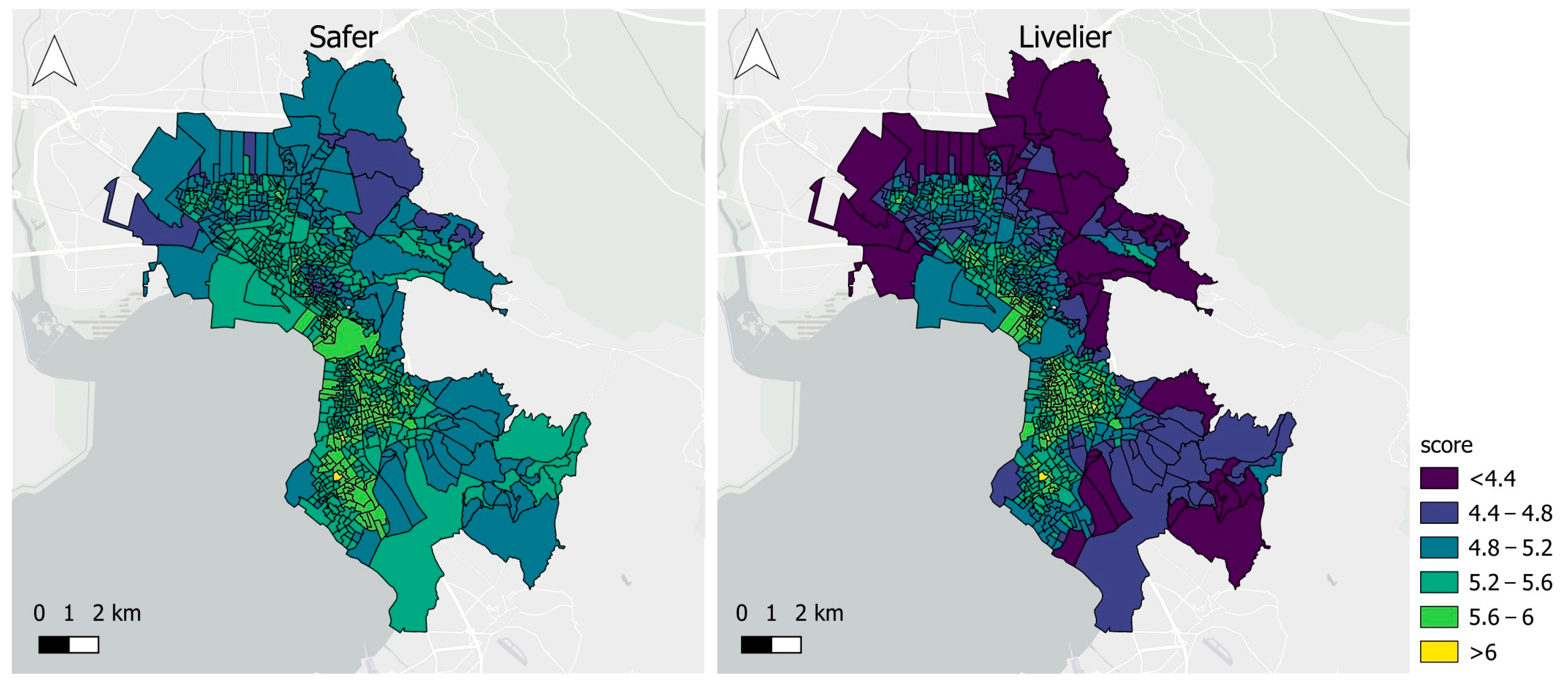
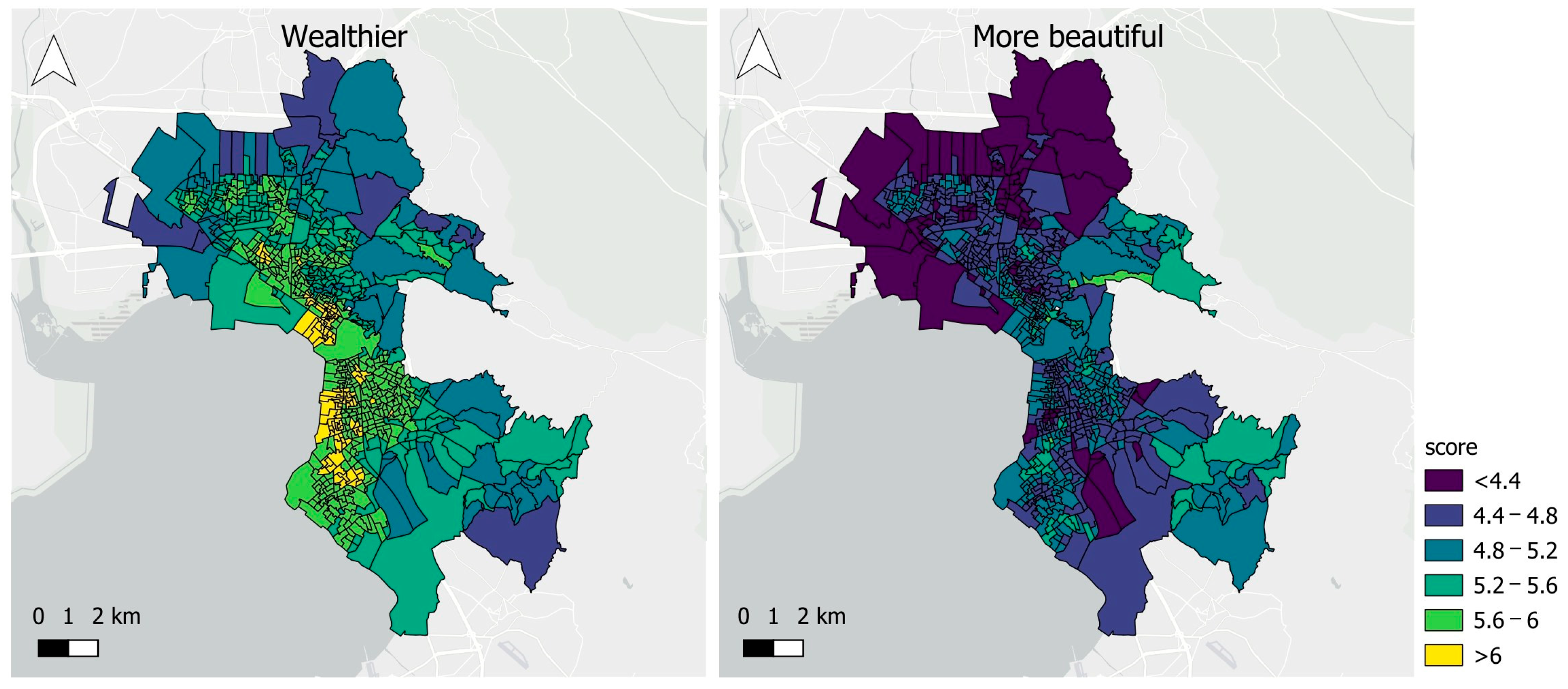
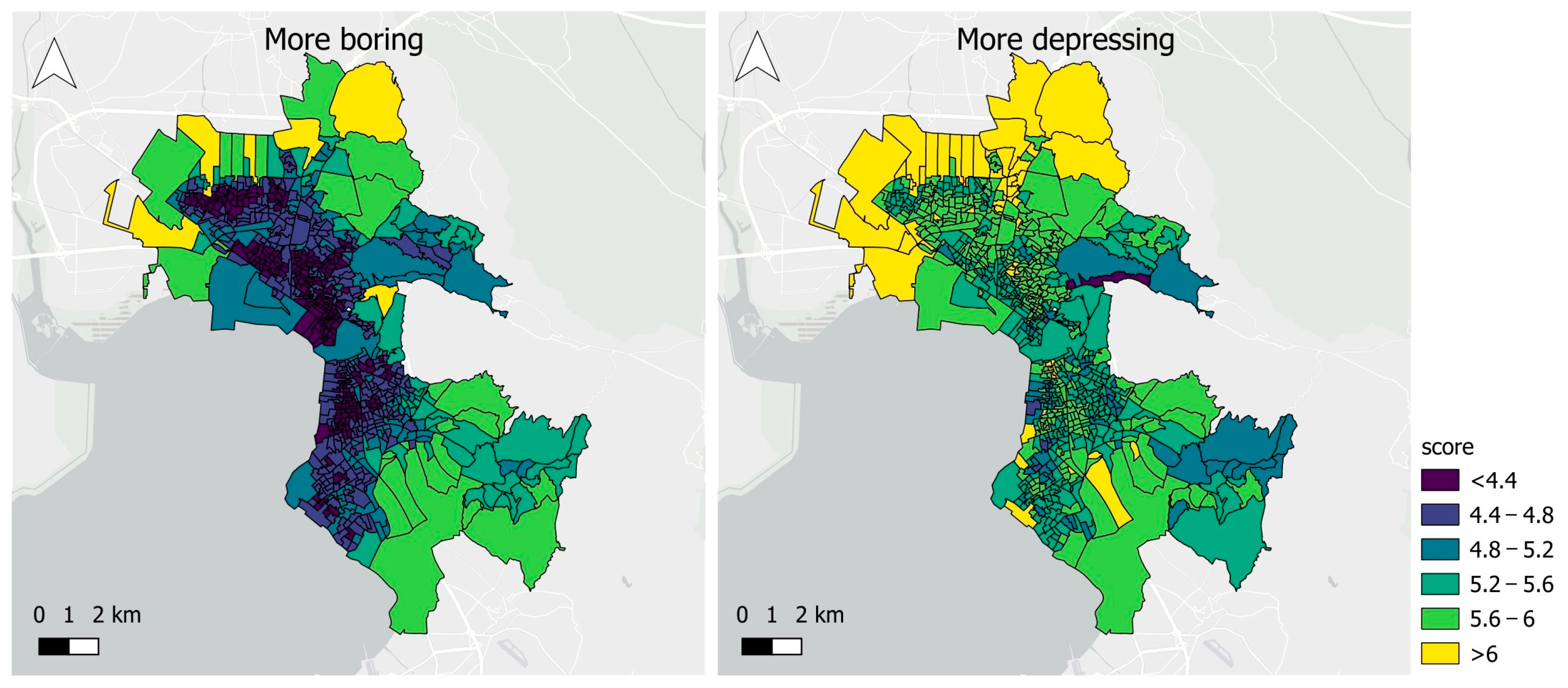

| Variable | Code | Description/Notes |
|---|---|---|
| Industrial Employment | EC_LQ1 | Share of employed population in industrial sector. |
| Commercial & Public Sector Employment | EC_LQ2 | Share of employed population in commerce and public sector. |
| Directors | EC_LQ3 | ELSTAT Code 1 (Hellenic Statistical Authority, 2011) |
| Freelancers & Technology Professions | EC_LQ4 | ELSTAT Codes 2–3 (Hellenic Statistical Authority, 2011) |
| Office & Services | EC_LQ5 | ELSTAT Codes 4–5 (Hellenic Statistical Authority, 2011) |
| Technicians | EC_LQ6 | ELSTAT Code 7 (Hellenic Statistical Authority, 2011) |
| Industrial & Non-Specialized Workers | EC_LQ7 | ELSTAT Codes 8–9 (Hellenic Statistical Authority, 2011) |
| Unemployment Rate | EC_LQ8 | % unemployed, relative to total employed (job-seekers included, non-active excluded). |
| Non-Active Population | EC_LQ9 | % non-active, relative to total population. |
| Property Values | EC_LQ10 | Official state-defined (“objective”) property values. |
| Nationality—Greek origin | SOC_LQ1 | Greek nationality. |
| Nationality—Developed countries | SOC_LQ2 | Western/Northern/Southern Europe and developed non-European countries. |
| Nationality—Eastern Europe | SOC_LQ3 | Non-developed Eastern European countries. |
| Nationality—Global South | SOC_LQ4 | Middle East, North Africa, and other less developed countries. |
| Households with >1 car | SOC_LQ5 | 2–6 cars per household. |
| Households without a car | SOC_LQ6 | Zero-car households. |
| Households without internet | SOC_LQ7 | No internet access. |
| Small residential space | SOC_LQ8 | <20 m2 per person. |
| Large residential space | SOC_LQ9 | >50 m2 per person. |
| Very High education | SOC_LQ10 | Master’s/PhD degrees (children < 5 years old excluded). |
| Very Low education | SOC_LQ11 | Primary school only or illiterate (children < 5 years old excluded). |
| Variable | PCA Component | |||
|---|---|---|---|---|
| F1 | F2 | F3 | F4 | |
| EC_LQ1 (Ind.) | 0.890 | |||
| EC_LQ2 (Comm. & Publ. Sect.) | −0.893 | |||
| EC_LQ3 Directors | 0.823 | |||
| EC_LQ4 (Freelancers & Techn.) | −0.719 | 0.610 | ||
| EC_LQ6 (Technicians) | 0.666 | −0.619 | ||
| EC_LQ7 (Indust. & Non-Specialized) | 0.631 | −0.639 | ||
| EC_LQ8 (Unempl.) | 0.782 | |||
| EC_LQ9 (Non-active) | 0.747 | |||
| EC_LQ10 (Property Val.) | −0.831 | |||
| SOC_LQ1 (Greeks) | −0.938 | |||
| SOC_LQ3 (Eastern EU) | 0.802 | |||
| SOC_LQ4 (Global South) | 0.870 | |||
| SOC_LQ5 (>1 car) | −0.563 | −0.570 | ||
| SOC_LQ6 (no car) | 0.718 | 0.579 | ||
| SOC_LQ7 (no Internet) | 0.468 | 0.536 | 0.484 | |
| SOC_LQ8 (small residence) | 0.898 | |||
| SOC_LQ9 (large residence) | −0.822 | |||
| SOC_LQ10 (v.high edu) | −0.744 | |||
| SOC_LQ11 (v.low edu) | 0.840 | |||
| Variable | Mean Moran’s I (200–600 m radii) | Min I | Max I | St. Dev. | CV | ρ |
|---|---|---|---|---|---|---|
| F1 | 0.795 | 0.755 | 0.835 | 0.031 | 0.039 | 0 |
| F2 | 0.728 | 0.599 | 0.949 | 0.138 | 0.189 | −1 |
| F3 | 0.417 | 0.38 | 0.452 | 0.029 | 0.07 | 0.4 |
| F4 | 0.165 | 0.105 | 0.251 | 0.062 | 0.377 | 1 |
| wealthier | 0.613 | 0.586 | 0.641 | 0.023 | 0.037 | 0.8 |
| safer | 0.587 | 0.539 | 0.621 | 0.034 | 0.058 | −1 |
| livelier | 0.582 | 0.538 | 0.604 | 0.028 | 0.048 | 0.7 |
| more beautiful | 0.498 | 0.425 | 0.58 | 0.06 | 0.12 | −1 |
| more boring | 0.468 | 0.404 | 0.518 | 0.046 | 0.099 | 0.4 |
| more depressing | 0.457 | 0.342 | 0.591 | 0.1 | 0.219 | −1 |
| Perception | Factor | r | CI (95%) | p | q (BH-FDR) | Significant (95% Level) |
|---|---|---|---|---|---|---|
| safer | F1 | −0.47 | −0.53 to −0.41 | <0.001 | 0.000 | ✓ |
| F2 | 0.12 | 0.04 to 0.19 | 0.003 | 0.004 | ✓ | |
| F3 | −0.06 | −0.14 to 0.01 | 0.103 | 0.124 | ||
| F4 | 0.18 | 0.11 to 0.25 | <0.001 | 0.000 | ✓ | |
| livelier | F1 | −0.40 | −0.47 to −0.34 | <0.001 | 0.000 | ✓ |
| F2 | 0.29 | 0.22 to 0.36 | <0.001 | 0.000 | ✓ | |
| F3 | −0.20 | −0.27 to −0.13 | <0.001 | 0.000 | ✓ | |
| F4 | 0.37 | 0.30 to 0.43 | <0.001 | 0.000 | ✓ | |
| wealthier | F1 | −0.51 | −0.56 to −0.45 | <0.001 | 0.000 | ✓ |
| F2 | 0.28 | 0.21 to 0.35 | <0.001 | 0.000 | ✓ | |
| F3 | −0.12 | −0.20 to −0.05 | 0.001 | 0.002 | ✓ | |
| F4 | 0.30 | 0.23 to 0.37 | <0.001 | 0.000 | ✓ | |
| more beautiful | F1 | −0.43 | −0.49 to −0.36 | <0.001 | 0.000 | ✓ |
| F2 | 0.00 | −0.07 to 0.08 | 0.958 | 0.958 | ||
| F3 | 0.19 | 0.12 to 0.26 | <0.001 | 0.000 | ✓ | |
| F4 | 0.04 | −0.04 to 0.11 | 0.312 | 0.356 | ||
| more boring | F1 | 0.07 | −0.01 to 0.14 | 0.076 | 0.096 | |
| F2 | −0.37 | −0.43 to −0.30 | <0.001 | 0.000 | ✓ | |
| F3 | 0.23 | 0.16 to 0.30 | <0.001 | 0.000 | ✓ | |
| F4 | −0.30 | −0.37 to −0.23 | <0.001 | 0.000 | ✓ | |
| more depressing | F1 | 0.41 | 0.35 to 0.47 | <0.001 | 0.000 | ✓ |
| F2 | −0.04 | −0.11 to 0.04 | 0.335 | 0.365 | ||
| F3 | −0.13 | −0.20 to −0.05 | 0.001 | 0.002 | ✓ | |
| F4 | −0.04 | −0.11 to 0.04 | 0.353 | 0.368 |
Disclaimer/Publisher’s Note: The statements, opinions and data contained in all publications are solely those of the individual author(s) and contributor(s) and not of MDPI and/or the editor(s). MDPI and/or the editor(s) disclaim responsibility for any injury to people or property resulting from any ideas, methods, instructions or products referred to in the content. |
© 2025 by the authors. Licensee MDPI, Basel, Switzerland. This article is an open access article distributed under the terms and conditions of the Creative Commons Attribution (CC BY) license (https://creativecommons.org/licenses/by/4.0/).
Share and Cite
Vartholomaios, A.; Lagarias, A. Mapping Urban Segregation with GeoAI: Street View Perceptions and Socio-Spatial Inequality in Thessaloniki, Greece. Land 2025, 14, 2083. https://doi.org/10.3390/land14102083
Vartholomaios A, Lagarias A. Mapping Urban Segregation with GeoAI: Street View Perceptions and Socio-Spatial Inequality in Thessaloniki, Greece. Land. 2025; 14(10):2083. https://doi.org/10.3390/land14102083
Chicago/Turabian StyleVartholomaios, Aristotelis, and Apostolos Lagarias. 2025. "Mapping Urban Segregation with GeoAI: Street View Perceptions and Socio-Spatial Inequality in Thessaloniki, Greece" Land 14, no. 10: 2083. https://doi.org/10.3390/land14102083
APA StyleVartholomaios, A., & Lagarias, A. (2025). Mapping Urban Segregation with GeoAI: Street View Perceptions and Socio-Spatial Inequality in Thessaloniki, Greece. Land, 14(10), 2083. https://doi.org/10.3390/land14102083









